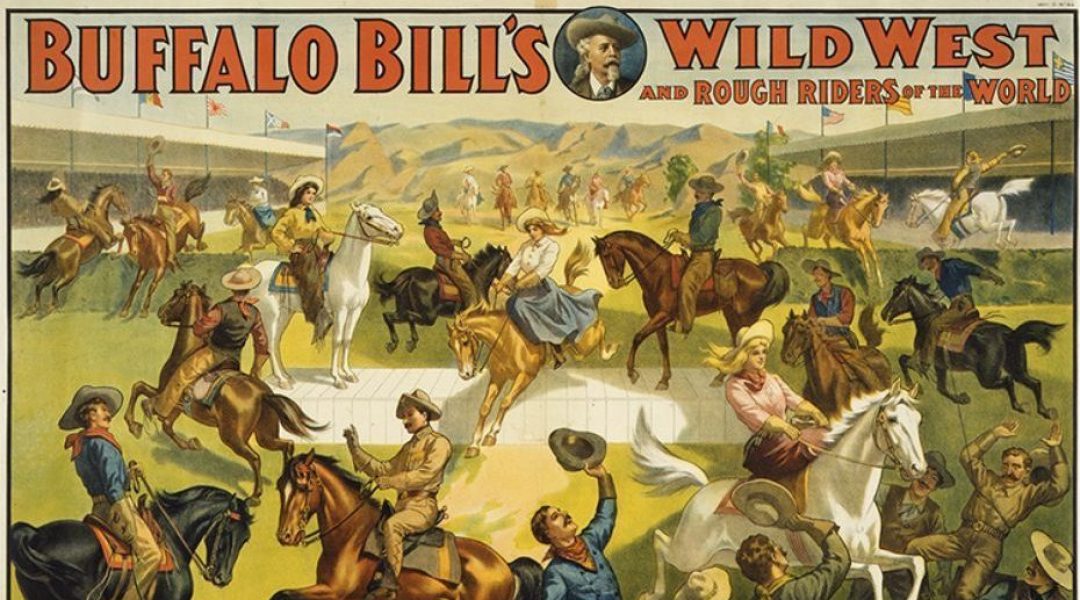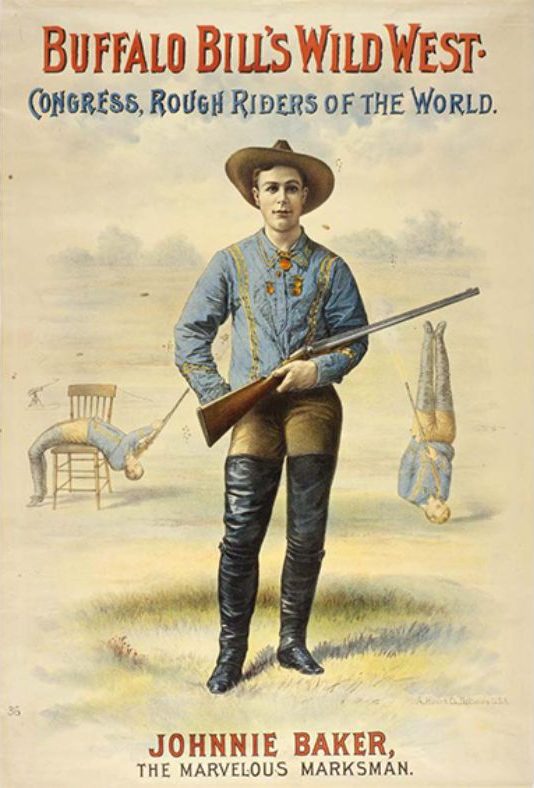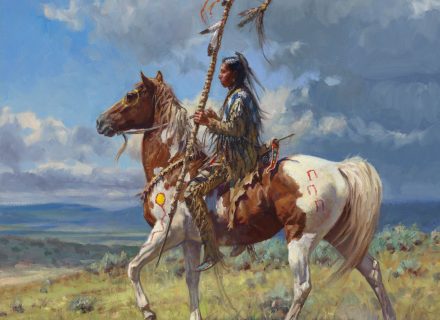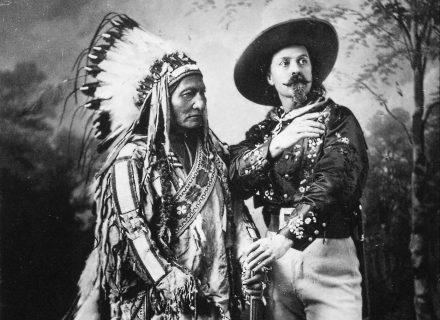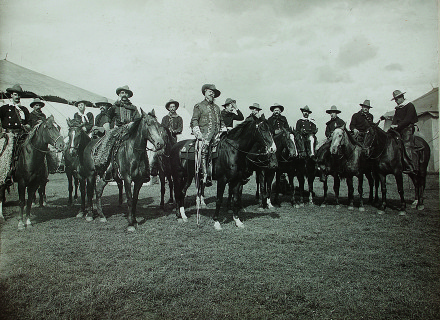A new exhibition at the Buffalo Bill Center of the West shows how poster art for Col. Cody’s famous show advertised the frontier myth and the West itself.
Horseback daredevils, skilled sharpshooters, dramatic moments in Western American history — you can find out how poster art for legendary showman Col. W.F. Cody’s Wild West advertised the frontier myth in an exhibition of more than 30 large-scale vintage posters and original photographs at the Buffalo Bill Center of the West through January 12, 2025, in Cody, Wyoming.
Buffalo Bill’s Wild West got recognition from its namesake showman, but also due to its tremendous marketing success. Cody’s team of marketers, led by Major “Arizona John” Burke, produced countless posters highlighting the presentation’s scale and drama.
The poster collection at the Buffalo Bill Center of the West includes more than 300 originals, from smaller posters for window display to enormous billboard-sized works. The special exhibition Advertising the Frontier Myth: Poster Art of Buffalo Bill’s Wild West features the captivating world of Buffalo Bill’s Wild West through some of the center’s finest selections and newest acquisitions.
Based on the award-winning book Art and Advertising in Buffalo Bill’s Wild West (2019), by guest curator Dr. Michelle Anne Delaney of the Smithsonian Institution’s National Museum of the American Indian, the exhibition is dedicated to Dr. Jeremy M. Johnston, a longtime cherished member of the Center of the West staff for more than 15 years, until his untimely passing in June 2024.
C&I talked with Delaney about the Buffalo Bill’s Wild West and how the posters for it did more than advertise the show.
Cowboys & Indians: What’s in the exhibition?
Michelle Delaney: The exhibition highlights original Buffalo Bill’s Wild West advertising posters and related photographs from the collections of the Buffalo Bill Museum and McCracken Research Library, Buffalo Bill Center of the West in Cody, Wyoming, as well as digital interactives incorporating reproductions of posters too large or fragile to display. The Buffalo Bill Museum holds over 300 original posters in its collection and has recently acquired another 50 posters from the Jack Rennert Collection. Rennert, a New York City poster gallery owner, has been collecting these rare promotional posters used to advertise the Wild West since 1959. The sale of the Rennert personal collection to the Buffalo Bill Museum is one of the most important collection purchases in the history of the Buffalo Bill Center of the West and represents new and significant U.S. and European posters being added to the center's already premier collection.
The content of the exhibition is based on my original research on the museum’s poster collection, which is presented in my book Art and Advertising in Buffalo Bill’s Wild West (University of Oklahoma Press, 2019).
C&I: What was the purpose of the posters?
Delaney: The Wild West Company promotional team and “bill posters” used everything from small shop window-sized posters to billboard-sized posters to cover buildings and fences along the train routes of the annual Wild West tours from 1883 to 1913, to alert and engage local communities to buy tickets for upcoming performances.
C&I: What is the larger import of them in terms of “advertising the frontier”?
Delaney: Buffalo Bill’s Wild West advertising posters introduced William F. “Buffalo Bill” Cody, the Native American Indian performers, sharpshooters like Annie Oakley and Johnny Baker, and the military equestrians of the Congress of Rough Riders of the World, to cities and towns across the United States and Europe in advance of the tour stops. Wild West program annual favorite segments, like Attack on the Deadwood Stagecoach and Custer’s Last Stand, were depicted on the promotional posters and in Wild West program books. The poster imagery glorified the achievements of Buffalo Bill Cody and the romanticism of the myths of the American West and frontier life, the vanishing buffalo, and stereotypical depictions of American Indians as the enemy of the U.S. military and scouts like Cody. Some American Indian performers in the Wild West may have actually participated in the historic battles being played out in the Wild West arena performances.
C&I: What was the effect of “advertising the frontier” on the frontier itself and the country?
Delaney: Buffalo Bill’s Wild West served as a catalyst for increased domestic and international interest in the American West territories. Cody was a consummate showman and entrepreneur who with his Wild West Company partners inspired further exploration travel, and development in Western states. The town of Cody, Wyoming, was established in 1896, following some of the most profitable years of the Wild West tours.
C&I: When you look at specific posters, what are some of the things you would point out to viewers to notice?
Delaney: William F. “Buffalo Bill” Cody is often central or highlighted in the advertising posters. But, over decades, the posters become much more diverse presenting a full range of hundreds of performers who traveled with the Wild West each year and the types of program segments audiences would get to see twice daily in every city or town.
C&I: If there are a couple of most important posters, which are they and/what is their significance?
Delaney: Several of the newly acquired Rennert Collection posters are huge, billboard-sized poster prints and unique, not held by any other museums or institutions in the U.S. Some of the European tour posters have not been seen by U.S. experts ever.
C&I: How did you get interested in these posters?
Delaney: I got interested in researching the Wild West posters through a fellowship at the Buffalo Bill Center of the West, advancing my research on a specific collection of photographs of Sioux Indian performers from the 1898 Wild West tour held in the collection of the Smithsonian National Museum of American History.
C&I: Where do you find them? How rare are they?
Delaney: Three U.S. museums hold the largest collections of Buffalo Bill’s Wild West posters: the Buffalo Bill Center of the West (over 300); the John and Mable Ringling Museum, Sarasota, Florida; and Circus World Museum, Baraboo, Wisconsin.
C&I: Tell us about the artistry. What is known about the artists?
Delaney: Individual artists working for lithographic printers mostly created the poster artwork for Buffalo Bill’s Wild West, but unlike other Wild West shows and circuses, Cody also established lasting relationships with several leading artists of the era to create or influence poster designs, including Frederic Remington and Rosa Bonheur.
C&I: What was the role of William F. Cody in the design of these posters?
Delaney: Cody and his partner, Nate Salsbury, were deeply involved in all aspects of the Wild West Company, including overseeing the yearly promotional poster designs and printing contracts. Much related archival material and Wild West Co. business records are now digitized and available online from the McCracken Research Library at the Buffalo Bill Center of the West, and American Heritage Center, University of Wyoming at Laramie.
C&I: How was Cody consciously promoting the frontier and the West in these posters, or was that just an accidental byproduct of his main concern of promoting his Wild West show? Or are they one and the same?
Delaney: My research shows the Wild West Company and publicity department for the traveling exhibition were implementing many advertising techniques and marketing methods that led to modern American advertising practices in the 20thcentury.
C&I: Where would you find these posters in their day? What kind of paper? Printing process? Size?
Delaney: Larger Wild West posters were pasted and affixed to building façades, fences, and barns, and smaller window advertising posters were placed inside shops and in window displays. Depending on the decade, the printing methods for the advertising posters were different. Generally, the earlier posters were woodblock prints, and later posters for Buffalo Bill’s Wild West were lithographic prints.
C&I: Who created the messaging, and what kinds of messages about the frontier do they convey?
Delaney: Yearly publicity and any messaging were created and marketed by Maj. John Burke, who led this Wild West team throughout the history of the tours. Buffalo Bill’s Wild West was always advertised as an educational exhibition, never a “show.” The Wild West arena program highlighted horsemanship and diverse military equestrian skills (Congress of Rough Riders of the World), American Indian performers, marksmanship and target shooting, and there was a “side-show” offering outside the Wild West arena, less frequently advertised in the existing posters. See Joe Dubrow’s book on Burke.
C&I: Any other points and/or related stories you’d like to share?
Delaney: Advising the Buffalo Bill Museum staff on the acquisition of the Jack Rennert Poster Collections has been a highlight of my professional history and museum career. It is gratifying to know that these important late-19th and early 20th century posters will remain together in the center’s collection for new scholarly research and to be enjoyed by generation of visitors to come.
Michelle Delaney is the acting associate director for museum research and scholarship at Smithsonian National Museum of the American Indian.
PHOTOGRAPHY: Courtesy Buffalo Bill Center of the West






